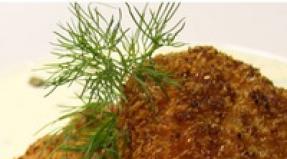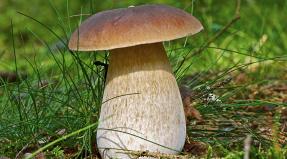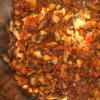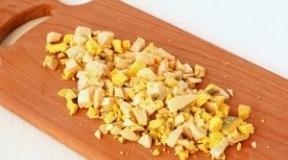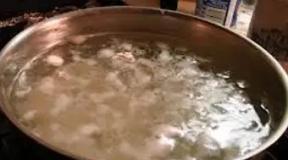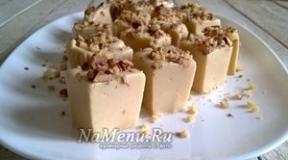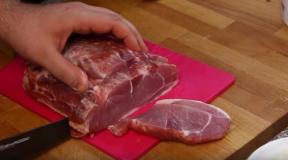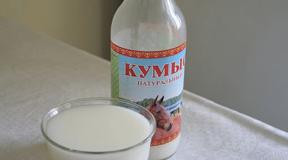How to taste wine: the subtleties of professional tasting. Three stages of wine tasting
The assessment of the quality of wine is carried out by expert tasters, guided by a certain set of rules developed over more than one century - during the time that winemaking has existed on earth. The taster determines not only the taste of the wine, but also its color, texture, aroma. Before tasting wine, you can not eat chocolate, drink coffee, smoke. All of these can affect perception. taste characteristics wine, and then the quality assessment grape wines(however, like everyone else), will be wrong.
According to professional terminology, wine tasting is a sensual and emotional assessment of the qualities of the product under study through contemplation, smell and taste.
Many of you have probably been to various events that included wine tasting. Well, for those who have not had a chance to attend this amazing event yet, just a few words about what wines start the tasting with and what they end with.
This knowledge will be useful to you if, even for a small number of guests invited to the house, you will have prepared different varieties wines
How to conduct a wine tasting
Before tasting wine correctly, one cannot but recall the well-known saying: “There are no comrades for the taste and color.” With regard to wine tasting, it can be rephrased in a more professional language - tasting, perception and evaluation of the taste of wines are a purely individual area, all people feel and interpret their sensations in different ways.
Therefore, the final selection of priority wines will always be solely your personal choice, since we are talking now not about professional, but about home tasting.
According to the rules of wine tasting, they start from simple drinks, gradually moving to more complex ones. White wines are tasted first, then reds. From tasting dry wines, they move on to fortified sweet ones. First they taste young wines, then more mature ones. And, accordingly, they move from less strong wines to stronger wines. No wonder there is an expression among the people: "Drink with an increase in the degree."
Here is a simple sequence of wine tasting.
Before even holding a wine tasting, take care of the right wine glasses. Their shape, the glass from which it is made, the height of the legs, etc. play an important role in revealing the bouquet and taste of wines.
The "king" of wine glasses is a tulip-shaped glass, the bowl of which is made of fine crystal good quality and a high degree of transparency. The stem of a wine glass should be long, thin and graceful, corresponding in height to approximately the average length of the hand.
Such criteria for the shape of a wine glass will allow you to fully enjoy not only palatability drink, but also admire the thick wine, seductively flowing down the walls crystal glass, to get as much information about it as possible, to remember this miracle in a glass and the impression received from the tasting.
Wine tasting rules and photos
There are a number of wine tasting rules, without observing which it is impossible to determine the quality of the drink. First, it's important to remember what to keep wine glass you need only for the leg, but not for the bowl. There are a number of reasons for this.
1. The wine will be slowly warmed by the temperature of your hand. This is the difference between wine tasting and cognac, a glass with which, on the contrary, you need to hold in your hand by the bowl, warming this drink as much as possible.
2. Due to the difference in body temperature and the glass of wine that you hold in your hands, fingerprints remain on the bowl - this is an unpleasant sight that reduces the impression of tasting drinks.

3. During the tasting, you need to look at the wine with love, gently rotating the glass by the stem. And if you rotate the glass by the bowl, then there is a high probability of throwing wine on yourself, ruining your clothes and mood.
It would not be superfluous to recall that wine glasses should be perfectly clean, well washed from stains and odors and, most importantly, thoroughly rinsed under running water, since the residue detergent or just its smell can absolutely distort the taste of wine, or even just spoil it.
The next important requirement for a wine glass is that it must be wiped dry and carefully polished with fresh cotton kitchen towel without the presence of any fibers in the fabric.

As you can see in the wine tasting photo, the glass must be perfectly shiny and transparent.
To feel the bouquet of wine, enjoy its aroma, you should slightly rotate the glass to the sides, holding it by the stem, so you need to pour the drink no more than one third of the volume of the glass.
Remember a few more useful rules to help you identify defects in wine.
1. Wine that has a musty smell, which means that it was prepared in violation of technology or spoiled during storage, as a rule, has a very unpleasant taste.

2. The same can be said in the case of choosing a poor-quality cork for corking wine - if, when you bring a glass to your nose, you clearly feel the characteristic taste of a cork, then the taste of wine will also be unpleasant.
3. An excess of sulfur, which also happens when the technology for making wine is violated, gives the drink a rotten shade and a characteristic smell of garlic.
4. White wine, oversaturated with oxygen, will have an acetic-sour taste, reminiscent of ascorbic acid, and red wine, with the same problem, will acquire the taste of spoiled fruit in alcohol.
5. Excess alcohol in wine will give a burning sensation in the mouth, which is incompatible with wine taste.
6. Excessive sugar content will create an imbalance in the drink and give the wine an obsessive and heavy cloying taste, making it look like a quick liqueur.
7. If the technology for making wine has been violated by the fact that the tannins in it have not matured enough, then the young wine will have a frankly bitter aftertaste, and older wines will acquire a dryish taste that will deprive the drink of all its charm.
It is curious that the same type of wine can be perceived differently depending on many external factors: natural season, time of day, wall color, lighting and temperature in the room where the tasting takes place. Also, a purely human factor plays an important role - the mood and well-being of the taster, as well as the food that he took shortly before the wine tasting.
In order to fully reveal the bouquet and aroma of the drink, it is not recommended to smoke during the tasting, and use perfumes before it starts.
Wine tasting is carried out in several stages, each of which is sequentially assessed for appearance, aroma, texture and taste.
The definition of color is the assessment appearance and the first impression of the wine.

Wine should be viewed through the light against a light background. The ideal option as a white background there will be a white tablecloth or a regular one White list paper.
A wine glass should be held vertically by the stem, after which you should tilt the glass away from you and carefully examine the shades.

Young red wine usually has a bright color with a slight purple or raspberry tint, which may change later.

Young white wines can range from completely colorless to light yellow or light greenish. Older wines take on an amber hue.
The intensity of the color shade of wine depends on many reasons, but to a greater extent on the grape variety.
Transparency- Another important indicator for wine. The wine should be free of sediment and bubbles. A cloudy shade with a suspension of small particles of grapes is considered a defect in the wine.
Fluidity- This is an indicator by which the structure and viscosity of wine are judged. Fluidity is easy to determine by rotating the wine glass in a circular motion. The wine will flow down the sides of the glass to its original level, leaving behind the so-called "legs".
Experts believe that the more of them, and they slide longer, the thicker the wine. But it is better to determine the structure of the wine not in one visual way, but in the mouth, during direct tasting.
Effervescence- another feature sparkling wines. In other words, this is the size and activity of the movement of bubbles that rise from the bottom of the glass. How better wine, the smaller and more intense the movement of carbon dioxide bubbles.
Characteristic aromas of wines
 The olfactory assessment of wine is the most crucial moment of tasting, since it is the notes of aroma that contribute to the formation of taste sensations.
The olfactory assessment of wine is the most crucial moment of tasting, since it is the notes of aroma that contribute to the formation of taste sensations.
Also at this stage, the persistence of the aroma is determined, which comes to life and reveals even more when the glass is rotated in the hand.
Aromas of wines are divided into three main groups.
Primary flavors- they are distinguished by a feature inherent in the grape variety from which the wine is made.
Secondary flavors arise from alcoholic fermentation as a result of the fermentation of the wort. They are more noticeable in young wines.
Tertiary- these are the characteristic aromas of wines that the drink acquires during aging and after fermentation is completed (in a barrel or bottle).
Taste evaluation of wine involves not only the determination of taste, but also the touch of the structure and consistency of the wine.
The receptors of the tongue, located in different parts of it, are able to distinguish four basic tastes: sweet, bitter, sour and salty.
Astringency is the definition of the astringent properties of wine. Basically, this indicator refers to red wines that contain tannins.
aftertaste- the final chord of tasting. It is the sum total of aromatic sensations and aftertaste. It is believed that the longer the aftertaste is felt, the better quality guilt.
Attention: This article is intended for persons over 18 years of age.
Whenever you visit a country rich in wines, tasting them is one of the most rewarding and worthwhile excursions. If you take a long walk through the vineyards and admire vine and picturesque scenery, glass in hand, you must first learn to appreciate the subtle beauty of wine.
Steps
- Spit the wine into a special "spittoon" if you have many other wines to taste. Drinking alcohol can reduce your tasting ability. And even more so, if you are driving, you should definitely use the "spittoon".
-
Breathe in through the wine. Press your lips together as if you were about to whistle, draw some air into your mouth and exhale through your nose. This releases the aromas of the wine and allows them to reach the nose where they can be recognized. The nose is the only place where the bouquet of the wine is recognized. However, enzymes and other chemicals in your mouth and saliva often change the mixture of wine flavors. By inhaling through wine, you are looking for completely different aromas, separate from those that were in interaction with the oral environment.
Take another sip of wine, but this time (especially if you are drinking red wine) let it come into contact with air. In other words, sip it while smacking your lips (without a loud slurping sound, of course). Notice the subtle difference in taste and texture.
Feel the aftertaste. How long does it stay? Do you like the taste?
-
Describe your entire experience on paper. You can use any terminology you like. The most important thing is to describe your impression and how much you liked the wine. Many wineries provide their own booklets and pens so you can take notes about the taste during the tasting. This will make you discern the subtleties of the wine. Also, you will have useful records of what each wine tastes like and you can easily match it to food or according to your mood.
- Wine has 4 main components: taste, tannins, alcohol and acidity. There is sweetness in some wines, but it is only dessert wines. A good wine will have the right balance of all four characteristics. Tannins soften with age (see Tips for more details). Acidity is lost throughout the life of the wine as it undergoes chemical changes, including the breakdown of acids. The fruity taste will intensify and then disappear throughout the life of the wine. The alcohol content will remain unchanged. All these factors provide knowledge about when to drink or pour wine.
- Here is a list of the most common varieties of wine and their flavors (keep in mind that the area where the raw material grew, the method of harvesting and other technological features production have big influence on the character of the taste of wine):
- Cabernet - blackcurrant, cherry, other black fruits, green spices
- Merlot - plum, red and black fruits, green spices, floral flavor
- Zinfandel - black fruits (usually sticky), black spices
- Syrah (or shiraz, depending on where it grows) - black fruits, black spices, in particular white and black pepper
- Pinot Noir - red fruits, flowers, herbs
- Chardonnay - in a cool climate: tropical fruits; citrus fruits are slightly warmer in regions, and melon in warmer regions. With an increase in the proportion of malolactic fermentation, chardonnay loses green apple and turns into a milky note, apple, pear, peach, apricot.
- Sauvignon Blanc - grapefruit, white gooseberry, lime, melon.
- Malolactic fermentation (natural or artificial introduction of specific bacteria) imparts white wine creamy or buttery taste.
- Aging wine in an oak barrel will give it a vanilla or nutty taste.
- Other flavor identifiers are minerality, earthiness, and asparagus.
- "Tannins" is a very common term in wine tasting (usually red wines). They refer to the astringent, bitter constituents found in grape skins, stems and seeds, as well as in oak barrels in which the wine is aged. If you want to experience the taste of tannin, just take a bite of the stem or eat a Cabernet grape straight from the vine. In young red wines, tannins taste bitter and dry, while in aged ones they are more velvety and pleasant.
-
- At tastings you will run into people different levels wine knowledge. Some of them will have broad knowledge, but don't get too far away from them right away. "Wine snobs" tend to recruit and rant, but not every beginner is ready to accept this. However, if you join a savvy taster who is willing to share knowledge in a respectful manner, it will be very educational.
- When using lead decanters or glasses, there is a small risk of lead poisoning, directly dependent on the time the wine is exposed to lead. Therefore, you should consume wine in a lead vessel within 48 hours to avoid poisoning.
- Many wines are not recommended to be stored for more than a few days after opening. They lose their freshness and fruity taste. They also exhale and oxidize. However, very rarely, good wine becomes vinegar. Some people believe that this happens, but this is one of the myths about wine.
- Like golf, wine is associated with status and a business lifestyle. If you want to be accepted into the circle of wine connoisseurs, it can cost you dearly.
Look at the wine, namely around the edges. By tilting the glass slightly, you can see how the color changes from the center to the edges. Holding a glass against a background of something white, such as napkins, tablecloths, sheets of paper, you can see the true color of the wine. Consider the color of the wine and how clear it is. Color intensity, depth, and saturation do not necessarily correlate directly with quality. White wines get darker with age, while reds tend to lose their color, turning brownish, often slightly harmful due to deep red sediment at the bottom of the bottle or glass. It is good to inhale the smell of wine and feel its preliminary aroma, so that later you can compare it with the aroma after twisting the glass. Thus, you can detect foreign odors, indicating that the wine (bottled) is probably spoiled.
Rotate the wine in the glass. This is done to increase the evaporative surface area of the wine, it spreads inside the glass and reaches your nose, allows it to mix with oxygen and helps the aromas to develop.
As you swirl the glass, pay attention to the viscosity of the wine (how slowly it slides back down the sides of the glass). More viscous wines are said to have "legs" and are likely to contain more alcohol. While the wine looks beautiful on the outside, this has nothing to do with its quality, but may indicate its strength.
Breathe in the wine. First you need to bring the glass to your nose at a distance of a few centimeters. Then dip the tip of your nose into the glass. What do you feel?
Take a small sip of the wine, but don't swallow it until you've completed this step. The difference between drinking wine and tasting is that you have to spit it out! Swirl the wine around in your mouth to present it to all your taste buds. You will be able to taste only sweet, sour, salty, bitter and umami (spicy fifth taste of monosodium glutamate). Pay attention to texture and other tactile sensations, such as a discernible sense of weight and texture.
Here you will understand what good and bad wine means, and you will begin to get used to good wine. You don't have to send the wine back with the waiter unless you like the taste of it. It is better to send back the wine, the smell of which did not seem quite right to you, or the wine that, in your opinion, was completely out of steam.
Step #1. Check out its appearance
The first thing he does professional taster wine - checks its color. The way a wine looks can say a lot about its quality and origin.First of all, it is necessary to evaluate the color of the wine in contrast with the white background (a tablecloth on the table or a napkin is suitable for this). Tilt your glass slightly and notice the color of the wine and its depth.
Most unaged red wines appear dark purple. As the wine ages, its color loses depth and becomes paler. The color of a wine can also tell you a little about the grapes used to create it. For example, the color of the wine "Pinot Noir" will be the most pale.
The color check is also suitable for white wines, which deepen in color over time. In addition, white wines from countries with cooler climates do not sparkle as much as wines created in countries with warmer climates.
After checking the color of the wine, shake the glass a little and see how the wine flows down the walls. They say that what longer wine flows down the glass, the better the wine is. In fact, these are inventions. Such a viscous residue is just an indicator of the alcohol content. The longer the wine flows down the walls, the more alcohol it contains.
Step #2. Appreciate the flavor
During a wine tasting, it is necessary to evaluate its smell, or the bouquet of the wine. Shake the glass of wine again so that its smell appears in the air. Since the wine is still in the glass, feel free to stick your nose into the glass and inhale.Think about the smell from the glass: young wines have a fruity smell (notice the smell of raspberries or citrus, for example), older wines have complex aromas (including the smell of oak bark or grass).
Step #3. Pay attention to the taste
Once you've (finally!) started tasting wine, you need to know that every little flavor in wine can be tasted with your tongue. You can better appreciate the taste if you hold it in your mouth for a while, paying special attention to your sensations and taste in the back of your throat.When tasting, smack the wine a little to fully appreciate its taste. This does not mean that you need to throw your head back and gargle with it like a 6-year-old boy, you just need to smack your lips a little, and then the wine will find its own way.
Once the wine is in your mouth, think about the weight and shape of the wine: is it rich and heavy or light and thin?
Think about those flavor shades that you have noticed and ask yourself if this bottle is suitable for the food you eat. If the main course is a steak and the wine is light and fruity, then you need to find another wine.
Think about how the taste of wine changes in your mouth. Once a wine is opened, it takes a few moments for it to show off its full range of taste sensations, and the same thing happens in your mouth.
Step number 4. Appreciate the aftertaste of wine
Aftertaste is the feeling you have after you finally take a sip of wine. And it can be very different from the taste that you felt in your palate.What you need to pay attention to is the taste of alcohol (which you should not taste) and the time that the taste of wine stays in your mouth. This is called aftertaste.
The taste of some wines can last longer than one minute. Assess the balance of the wine. Are there any dominant flavors or does the wine have a distinct and defined taste?
In short, the longer the finish, the better the wine.
How to taste wine the right way? Why do you need to turn the glass in your hands? What are "tears of wine" and do you need to be a good physicist to learn to understand wines? Let's talk about this and much more with Italian sommeliers.
Those who want to learn how to understand and choose them correctly must follow the rules of tasting and know the properties inherent only in high-quality wines.
After reading our article, of course, you will not become Andrea Galanti and Enrico Bernardo, one of the best sommeliers on the world stage, however, you will learn to distinguish "ink" and mediocre wines from really good products wineries.
Andrea Galanti, best sommelier in Italy 2015. Photo vinoway.com
Here are 7 basic postulates of a sommelier.
Pour and take a look
The tasting glass should be filled one third. Then take the glass by the stem and bring it to eye level, tilt it slightly, observing the shade of the wine on a white background (use a towel or a piece of paper). This is done in order to better consider the tone of the wine (for whites, the hue varies from greenish for young wines to amber for aged, for reds - from purple to brick red). The rule, in principle, if you do not go into details, is one: aged wines always have a darker, more saturated color.

Slow rotation
Now slowly turn the glass to "feed the walls with wine" (avvinare le pareti). Take a close look at your glass. See the tears? If not, it means that the content ethyl alcohol there is probably little in your wine. "Weep" only wines with a high content of ethyl alcohol. In the picture you see a wine with an alcohol content of 13.5% - this is enough for the formation of "tears".
The term "tears of wine" was first used in 1865 by the physicist James Thomson, later the Italian physicist Carlo Marangoni devoted his own dissertation to the study of this effect, called the Marangoni Effect. Thus, thanks to wine, physicists were able to explain many of the phenomena observed in colloidal chemistry and hydrodynamics.
Thus, for the sommelier, there is only one conclusion from all this: the more “tears” already formed by wine and the slower they flow, the more structured and strong wine you are tasting.

Breathe in the wine
Inhale the aroma of wine by holding the glass in a fixed position. Inhale slowly and deeply, after a few seconds, move your nose away from the glass so you don't get used to the aroma. Remember that the first impression of a bouquet of aromas is the most correct.

Thorough study
Now rotate the glass again in a slow motion so that the wine covers the walls of the glass as completely as possible. So the wine aroma will reveal itself most clearly. At this point, the sommeliers evaluate the most important characteristics of the wine: aroma (it can be full, noble, pronounced, delicate, sophisticated, persistent, elusive, then, like the aroma of your favorite perfume, sweet, fruity, with a hint of spices, grassy ... ), its intensity (how strongly the aromatic bouquet is felt); persistence (how long the fragrance stays "in the nose"); complexity (the number of fragrances combined in a single bouquet); quality (the overall assessment of the bouquet is from "ordinary" to "complex" and "excellent").

Let's drink!
Finally, the time has come to taste the contents of the glass. Drinking small sip and hold it in the mouth without swallowing, so that taste buds reacted in the right way. The wine can be more or less sweet, delicate (if the taste of a velvety drink remains in the mouth) or sharp, more or less astringent (due to tannins), fresh or sour, light or structured. All qualities are evaluated based on personal feelings regarding the degree of saturation of taste sensations on the tongue after tasting.

We drink again and ... spit out
We take another sip, another sip, trying this time also to swallow a small amount of air to strengthen taste sensations. Good wine leaves an impression of harmony and balance between its main sweet, sour, bitter and salty constituents. After swallowing, focus on the taste: wait about 15 seconds to understand the aftertaste.
If the number of wines to taste is numerous, the wine can and should be spit out (certainly not in the way the people in the picture celebrate San Ferminio in Pamplona, Spain, of course).

Recording our feelings
Write to notebook experiences you get while tasting wine and compare it to other people's experiences if you're not tasting alone. To be more precise, you can use the established standard sommelier scoring charts (which can be found online). This way you can even create a personal library of favorite wines. With practice, you will soon see how quickly you can hone your skills.
Ability to understand alcoholic beverages only adds charm to any person. Therefore, knowing how to taste wine is considered to be the one that will help raise your status in the eyes of others. If you do not yet know the rules of such a test, then here is a small instruction that will help you feel like a connoisseur and connoisseur divine drink.
Where to begin?
Any tasting begins with the choice of dishes. So, with regard to wine, we can say that many factors can affect its taste. Therefore, the choice of a glass for tasting is the first and most important step to start the process.
A wine glass must meet a number of requirements that ensure that you fully experience the whole bouquet of the selected drink. Take a glass with a high stem. It is not for nothing that in all restaurants you can see just such dishes for drinks. In this case, the glass is held precisely by the leg, because contact with the drink can increase its temperature, and the taste will change.
Only clean utensils should be used. No matter how trite this advice may sound, the wine glass must be crystal clear so that no impurities interfere with the delicate aroma.
The glass is selected, the bottle is uncorked, which means that the tasting process can begin. Take the bottom of the bottle and pour the wine into the glass, holding it by the stem. Very important rule- the first pouring glass is kept for himself and only then begins to pour the wine to those present. The reason for this rule is quite simple - crumbs and specks from the cork can remain in the wine, so according to the rules of etiquette, we leave the first portion for ourselves, and pour the guests a clean drink.

Stages of tasting
Each tasting consists of several stages, the fact is that the wine is evaluated according to three main factors: appearance, aroma, taste. It is very important to follow the entire tasting order and know the subtleties of each stage. To evaluate wine, you need to consider how it looks, its smell and taste.

Assessing wine by appearance
The check of the drink begins with the appearance. Hold your glass of wine up to a light or any white background. remember, that quality drink should not be cloudy. Red wine allows for some sediment. Depending on age, the color may also change. For example, a young white wine will be clear, while an aged one will take on an amber hue. Also, different grape varieties can give a special shade. For example, grapes that grow in warm southern countries make the wine brighter, while northern varieties give a slightly dull tone to the drink.
You can shake the wine a little in the glass and watch it flow down the sides. If quickly, then you have a light wine with a minimum alcohol content. In the event that the liquid becomes viscous, you are going to try either sweet drink or wine with a high alcohol content.
Another requirement is put forward for sparkling, which concerns bubbles and foam. The bubbles should be small and last a long time. The best sign is a thin chain of bubbles that rises from the bottom of the glass.

Smell the glass
Now it's time to move on to the next stage of tasting - to evaluate the aroma. Slightly shake the glass and inhale the smell of the drink. The aroma of wine consists of a number of factors that give the bouquet its note.
First, it is the grape itself. It gives the drink a subtle fruity aroma that is more noticeable in young drinks. The second component is the result of fermentation. Hence and slight sourness. But the third aroma that is woven into the bouquet is the smell of a barrel in which the wine reached the desired condition. There is no certain ratio of these smells, which will tell about the quality. You can draw your own conclusions based on your preferences. Perhaps the smell of wood seems more attractive to you than the scent of fruit. Then look for a more aged drink that has managed to soak in the smell of an oak barrel.

Let's taste
To fully appreciate taste properties, you need not just take a sip, but hold the liquid in your mouth. The fact is that the taste zones are located over the entire surface of the tongue and distinguish different notes. So there are zones of sweet, sour and bitter. Therefore, the wine must touch every corner of the mouth in order for you to draw the right conclusion.
No need to swallow immediately, draw in a little air, pursing your lips with a tube, and exhale through your nose. Thus, you can fully reveal the taste of the drink and combine its smell and taste component into a common harmony.
Now that you have revealed the entire bouquet of aromas of the drink, you can swallow it. Pay special attention to the remaining aftertaste. It should not be a characteristic alcoholic shade. This is a sign of cheap wine, where the high alcohol content overrides low-quality raw materials. But the long aftertaste will tell you about the right choice.
It is important to remember that the taste may change depending on which dish is served on the table. It is for this reason that there is a whole science of how to choose the right wine for different products. If you want to fully enjoy the aroma of a divine drink, then be sure to follow the schemes of what can be served with white wine or red.
Don't be afraid to try new things and learn useful skills. And your ability to recognize high-quality and good alcohol on store shelves will only add a special charm to you and raise your status in the eyes of others.
Read also...
- Thai meat with vegetables - a classic recipe with step by step photos of how to cook beef with bell pepper and soy sauce at home
- Soft brushwood with cottage cheese: recipe with photo step by step
- Soft brushwood with cottage cheese: recipe with photo step by step
- Marinade for chicken How to marinate chicken meat for frying
